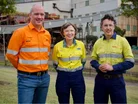Rio Tinto, BHP & BlueScope: Decarbonising Steelmaking

In a bid to accelerate the decarbonisation of steelmaking, Rio Tinto, BHP and BlueScope have partnered to explore the development of Australia’s first ironmaking electric smelting furnace (ESF) pilot plant.
Rio Tinto and BHP are Australia’s two largest iron ore producers, whilst BlueScope is the country’s biggest steelmaker. The agreement will see the consolidation of the work towards decarbonisation that the three leaders have made up to this point, leveraging both BHP’s and Rio Tinto’s deep knowledge of Pilbara iron ores with BlueScope’s unique operating experience in ESF technology.
“We are thrilled to partner with Rio Tinto and BlueScope to progress what we see as a potential breakthrough in reducing carbon emissions from steel production,” shares Tim Day, Incoming BHP Western Australia Iron Ore (WAIO) Asset President.
“Collaborations like this are so important for the success of these technologies and build on our work on blast furnace abatement projects, and our ongoing research and development projects with leading steelmakers, research institutes and technology providers around the world.”
“Combining our expertise, we hope to help fast track near-zero emission-intensity pathways for steelmakers using Pilbara ores,” Day continues.
“Technology pathways compatible with renewable energy and scalable to the order of hundreds of millions of tonnes of steel production would be a major step forward in setting up Pilbara ores, and the world, for a low greenhouse gas emission future.”
Sustainability in steel production
The future of steel is looking sustainable, as the collaboration looks to demonstrate that production of molten iron from Pilbara ores is feasible using renewable power when combined with Direct Reduced Iron (DRI) process technology. This is alongside the exploration of the pilot facility, which — if approved — could be commissioned as soon as 2027.
“The carbon intensity of iron and steelmaking requires profound change to meet the needs of our planet and our climate objectives. We must find better ways to enable these materials to be made more sustainably through leveraging technology,” believes Simon Trott, Rio Tinto Iron Ore Chief Executive.
“We firmly believe the best way to tackle a challenge of this scale is through collaboration with industry and importantly this new agreement will leverage the more than two years of work we have already completed with BlueScope on this technology. This partnership will benefit from Rio Tinto’s and BHP’s unrivalled experience of Pilbara ores as well as the technical steelmaking capability and unique operating knowledge of BlueScope. We are excited to add this partnership to the suite of projects we have underway with our customers and suppliers to find better ways to accelerate their efforts to meet their decarbonisation targets.”
If successful, the collaboration could illuminate a potential pathway to near-zero greenhouse gas emission-intensity operations for steelmakers that rely on Australian iron ore to meet global steel demand.
“We have a clear vision for BlueScope in Australia as a vibrant, modern and sustainable manufacturer with a clear role to play in enabling Australia’s energy transition,” says Tania Archibald, BlueScope Chief Executive Australia.
“Building a pathway to low emission-intensity iron and steelmaking in Australia is a key priority for our business. We’re excited to be partnering with Rio Tinto and BHP to explore the decarbonisation of the ironmaking process, and leverage the natural advantages of Australia – namely our iron ore resources and the abundant potential for renewable energy.
“We believe DRI is the most prospective technology to decarbonise our Australian business, and the development of ESF technology is key to unlocking Australia’s unique advantages in this decarbonisation journey – and, more importantly, has the potential for wider adaptation across the global steel industry. We believe that this collaboration where we can contribute BlueScope’s unique experience in operating an ESF will be key to cracking the code for Pilbara ores in low emission-intensity ironmaking.”
******
Make sure you check out the latest industry news and insights at Mining Digital and also sign up to our global conference series - Manufacturing LIVE 2024
******
Mining Digital is a BizClik brand
*************




